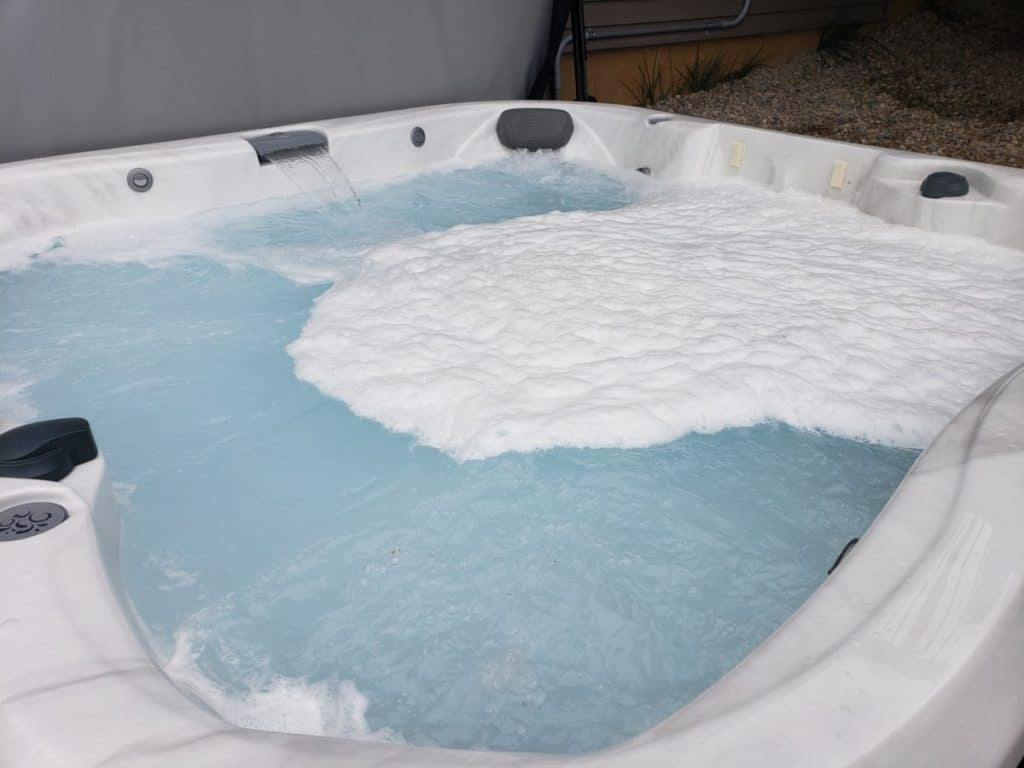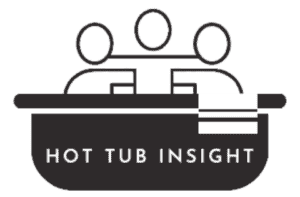This post contains affiliate links.

As I was waiting for my first hot tub to be delivered, I wanted to make sure I knew exactly how to take care of it before it arrived. That way I could hopefully avoid any newbie water care mistakes. One of the questions I had was how often I needed to shock my hot tub, well, this is what I found out.
It is best practice to shock your hot tub with a quality spa shock at least once per week. You may need to do this more often if you have a higher than average bather load or are having issues with water chemistry.
While once a week is a good starting point, your particular needs may differ. Continue reading to find out why.
When Should I Shock My Hot Tub?
If you follow the once per week guideline, the majority of the time you should have no issues. Unfortunately, this is not a one size fits all scenario, so there are going to be times when you need to adjust your weekly schedule. Without knowing your particular water situation, I will help you understand the times you will want to shock your hot tub. That way you can identify for yourself if you need to shock more or less often than the once per week guideline.
Before we jump into the details, we should first understand why we need to shock a hot tub. To answer that question we need to understand the three main hot tub water chemistry pillars.
Total Alkalinity – Best described as how well your water resists changes in PH levels
PH Levels – How acidic or basic is your hot tub water
Sanitizer Level – How much active sanitizer (chlorine or bromine) is in your hot tub water
These three components of your hot tub water chemistry work together. If one of them goes out of balance it will affect the other two. It can be a challenge to keep them in harmony but a good water chemistry routine will keep them in check.
For reference, here are the recommended ranges for each:
- Total Alkalinity: 80 – 120 ppm
- PH Level: 7.2 – 7.8
- Sanitizer Level: Chlorine 1.5-3.0 ppm and Bromine 3.0-5.0 ppm
Now that we understand the basics of water chemistry, we can focus on sanitizer level as it affects when you need to shock your hot tub the most.
A hot tub sanitizer like chlorine and bromine kill living organics in the water. As the sanitizer does its job the active level will decrease because it binds to the organic material. Chlorine becomes chloramine and bromine becomes bromamine. If you have ever pulled off your hot tub cover to be greeted by that wonderful chlorine smell, what you are actually smelling are the chloramines.
The purpose of spa shock is to oxidize the organics in the water which off-gasses the chloramines and bromamines freeing up your sanitizer to do its job again. This is why it is important to leave the cover off your hot tub when you shock it. You want the off-gassing process to complete. If the cover is on the hot tub the gasses will have no place to go and will redissolve into the water. It can also reduce the life of your cover over time.
So when should you shock your hot tub?
- When your sanitizer levels become unstable
- If your hot tub smells like chlorine
- When the water clarity or color is off
- After extended use or large bather load
- If you haven’t used your hot tub for a while and the sanitzier level is low
- On a regular basis if everything else is in check
How Do You Shock A Hot Tub?
To shock a hot tub you just need to follow a few simple steps:
- Remove the cover from your hot tub.
- Test and balance the PH and Alkalinity levels
- Turn on all the jets and air valves
- Measure out the recommended amount of spa shock
- Dump the shock into your tub and let it run for at least 15-20 minutes
Make sure you leave the cover off for the entire process to promote off-gassing. That’s it!
Are There Different Types of Shock?
There are multiple types of shock but only a few are recommended in a hot tub.
Dichlor Shock (Recommended)
You may have heard of dichlor chlorine granules, well dichlor shock contains the same active ingredient. Dichlor shock is a chlorine-based shock that will quickly raise the chlorine levels in your hot tub water to free up the existing sanitizer. You can use dichlor shock with chlorine and bromine.
Calcium Hypochlorite (Not Recommended)
Calcium Hypochlorite is a great product for use in pools that are kept at a much lower temperature than a hot tub. You may also know it by the name cal hypo. The problem with calcium hypochlorite is it breaks down rapidly at high temperatures. This makes it much less effective in a hot tub and therefore is not recommended.
Lithium Hypochlorite (Not Recommended)
You will struggle to find this type of shock because one of the materials used to make it, lithium, is in high demand for other industries. (Think Elon Musk and Cybertruck). Since all the lithium is currently being consumed by self-driving batteries on wheels, this product is not recommended.
Non-Chlorine Shock (Recommended)
Non-chlorine shock is only an oxidizer. This means it does not kill bacteria and cannot be substituted for a sanitizer. It is extremely effective at removing organics from the water and helping your sanitizer perform its job better. If you want to reduce the amount of sanitizer used in your chemical routine, you could use a non-chlorine shock more frequently so that your sanitizer works more effectively. Then you can use less of your sanitizer.
Can You Over Shock A Hot Tub?
As with all your chemicals, you can definitely overdo it with a shock product. This will probably happen to everyone at some point or another. The important thing to remember is you can always add more chemicals to your hot tub, not less. Be safe with your measurements and always refer to the manufactures instructions.
In most cases, overdoing it with the shock will not cause any long-term issues with your hot tub. That being said, I wouldn’t go dumping an entire container of shock into your hot tub. But if you do add more shock than needed you will likely just need to wait longer before you can use your hot tub again.
How Long Do I Wait After Shocking To Use My Hot Tub?
How long you have to wait after shocking your hot tub is entirely dependant on what type of spa shock was used and how well your water is balanced. If you are using a non-chlorine-based shock then you should be able to use the hot tub immediately after the off-gassing process has completed. This is usually 20-30 minutes. As always though, make sure you are following the instructions provided by the manufacture of the shock product you use.
For a chlorine-based shock product, you will have to wait for the sanitizer levels to return to normal before you can use the hot tub. This could take up to 24 hours if you shock with a high dose. Luckily, you can test the water to see exactly when it is safe to enter by measuring the active sanitizer level using a test kit or test strips.
What Is The Difference Between Hot Tub Shock And Hot Tub Sanitizer?
We already discussed the different types of hot tub shock and of the recommended types, the only one that could be used as a sanitizer is a chlorine-based shock (dichlor). Keeping that in mind, the only main difference between a chlorine-based shock and a sanitizer is the amount of sanitizer per dose.
A chlorine-based shock is designed to quickly raise the chlorine levels in your hot tub (shock it) to free up the existing sanitizer. After it has done its job it is no longer needed so the effects will fade quickly.
The chlorine or bromine-based sanitizer is designed to maintain a low level of sanitizer in your hot tub to continually kill living organics like bacteria and viruses. They are meant to be slow-release products or used in small doses. They will not oxidize the water effectively as a good spa shock will.
How Often Should You Shock A Salt Water Hot Tub?
Many people go bananas over salt water systems in hot tubs. Hot Spring is one of the major manufacturers that offer an onboard salt water system in its Highlife series of hot tubs.
Salt water hot tubs work by using a process called electrolysis to convert sodium chloride (NaCl), table salt, into chlorine. This process is done automatically and when working correctly can maintain a constant level of chlorine in the hot tub water. Sounds great right?
They definitely are not completely maintenance free and can be expensive to run, but that is for another post.
So if you have a salt water system in your hot tub or are considering purchasing one, do you also need to buy shock?
Yes, you will want to have a shock on hand, but you will likely only need a good non-chlorine-based shock product. The reason for this is the salt system will produce the sanitizer for you so the shock only needs to take care of the oxidation.


